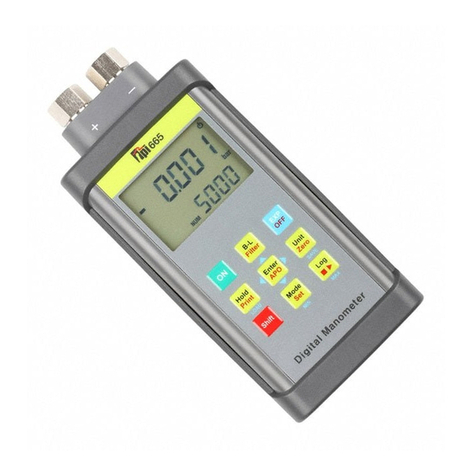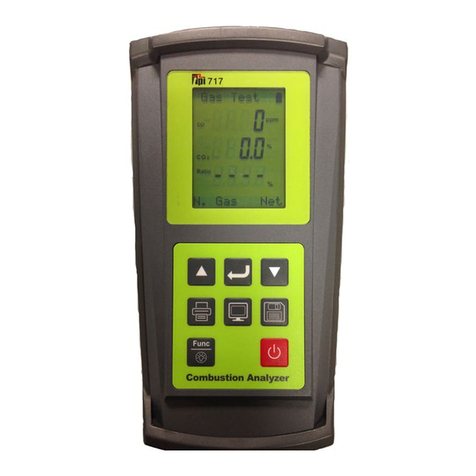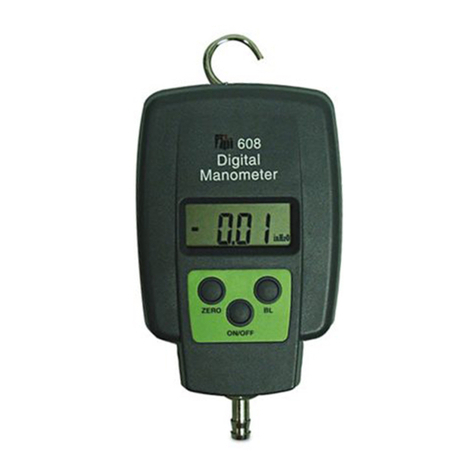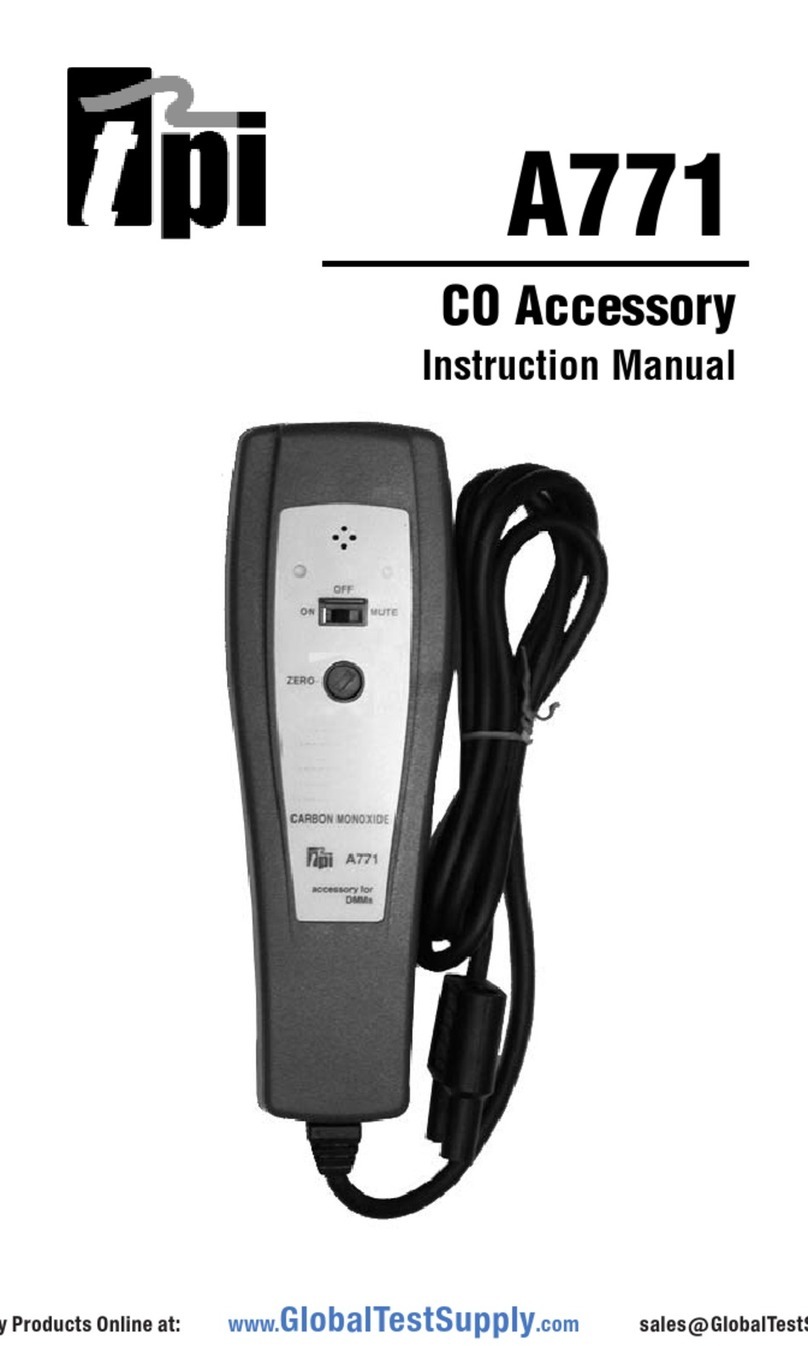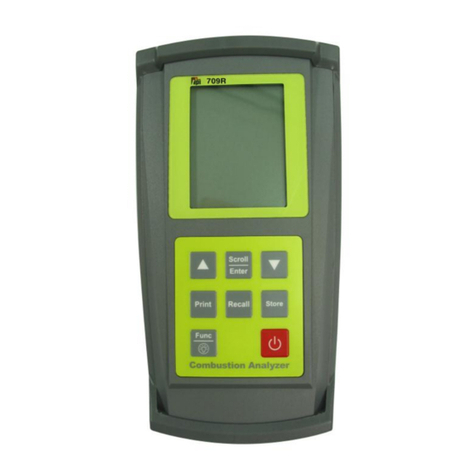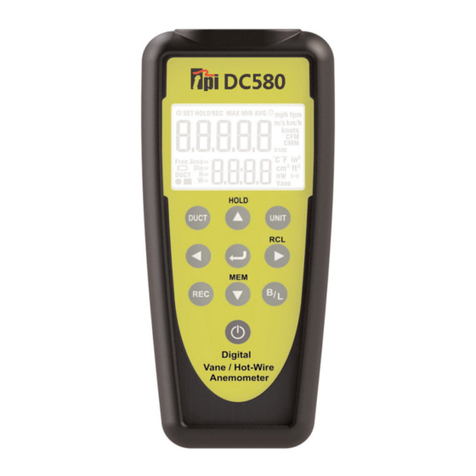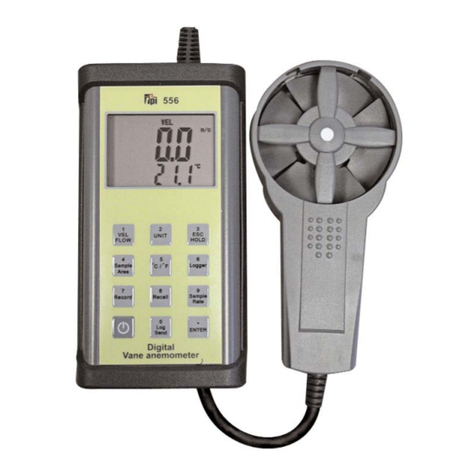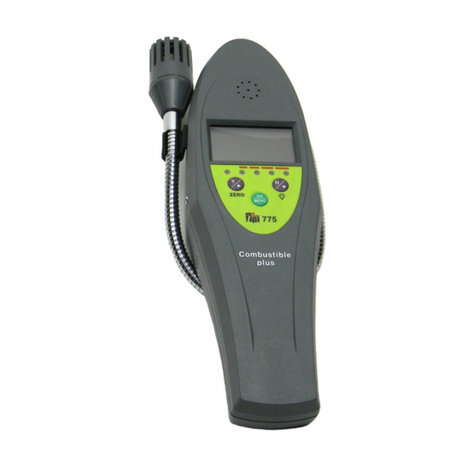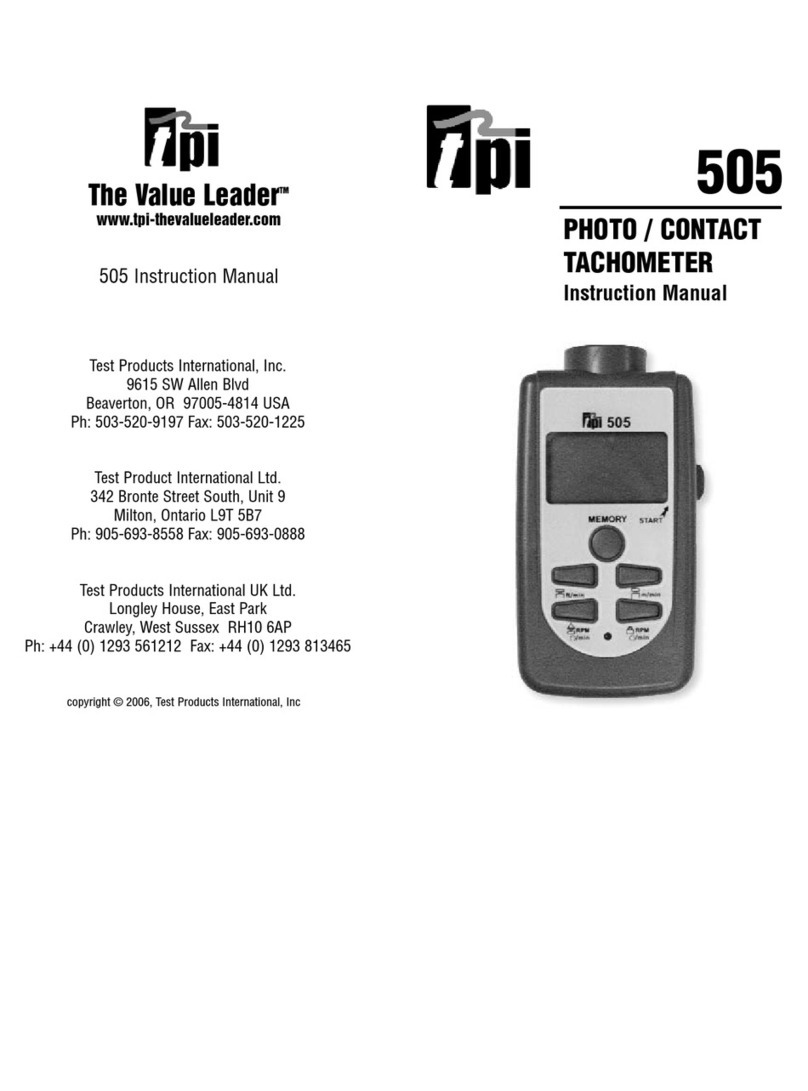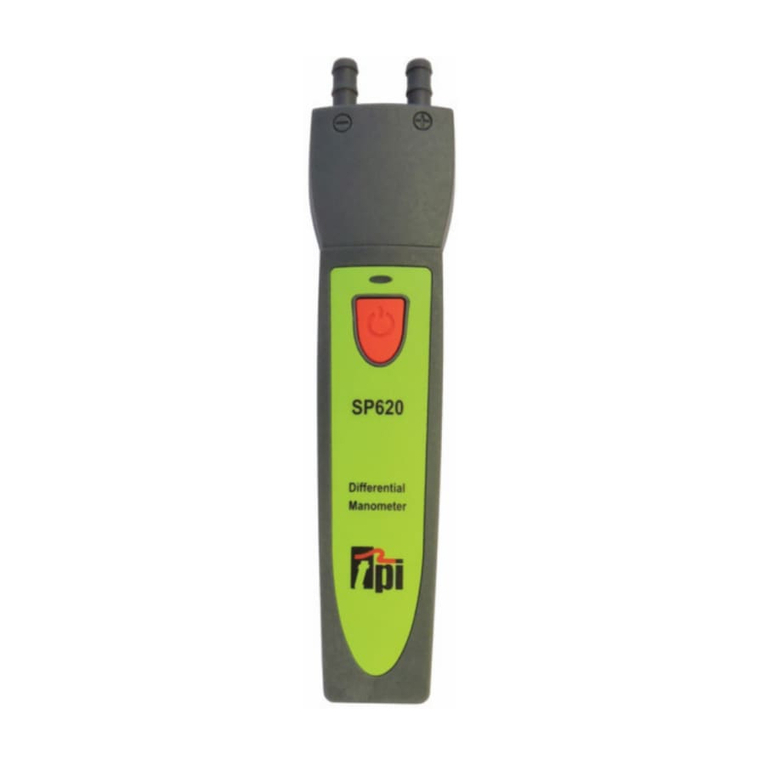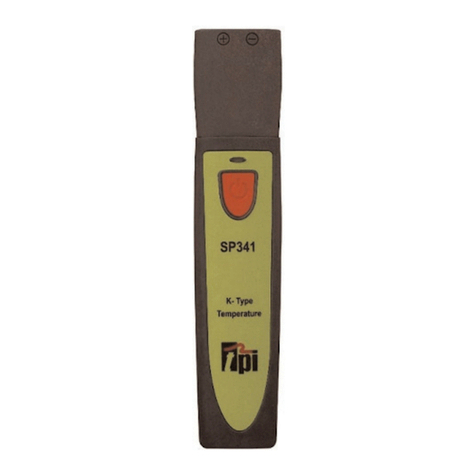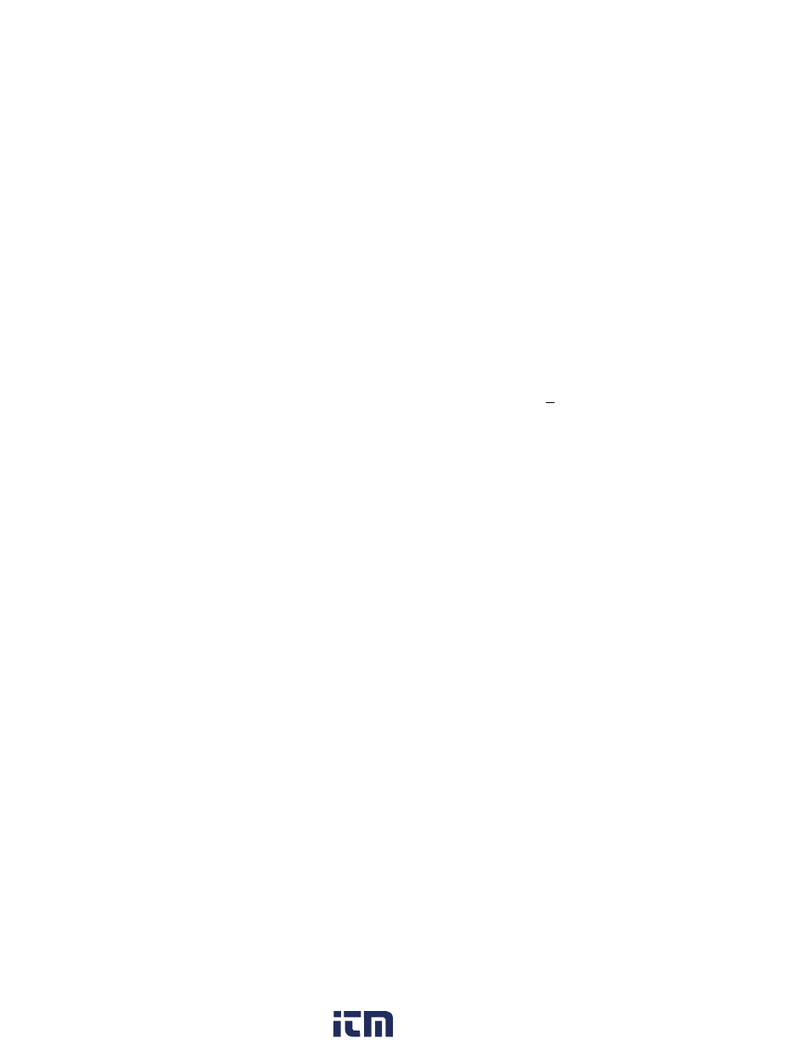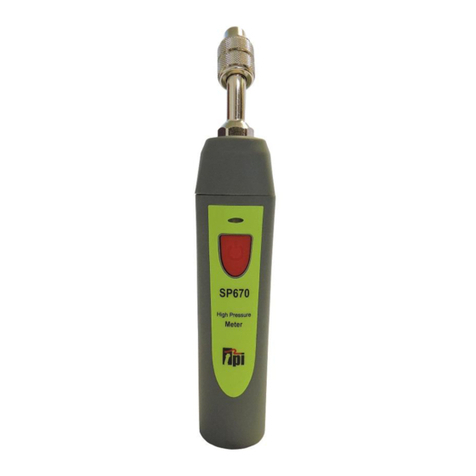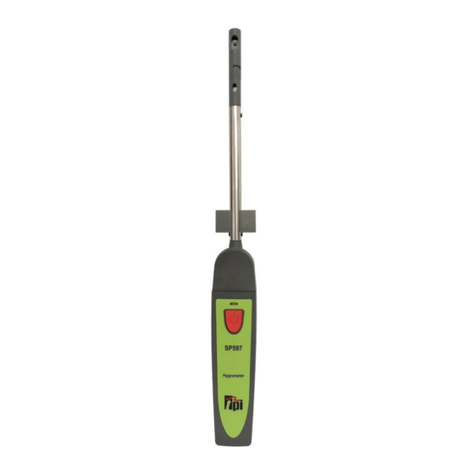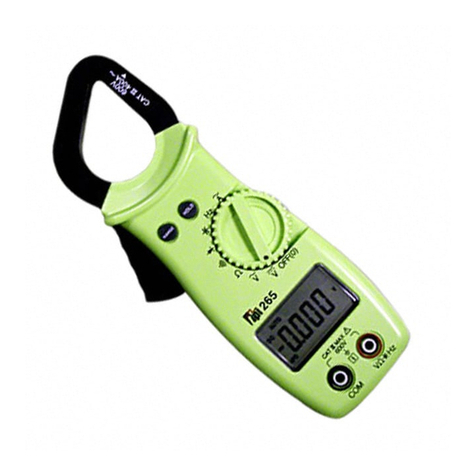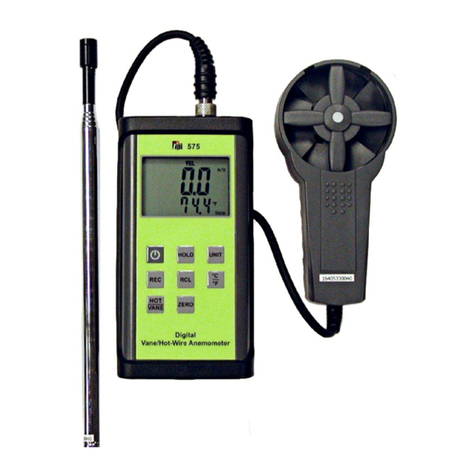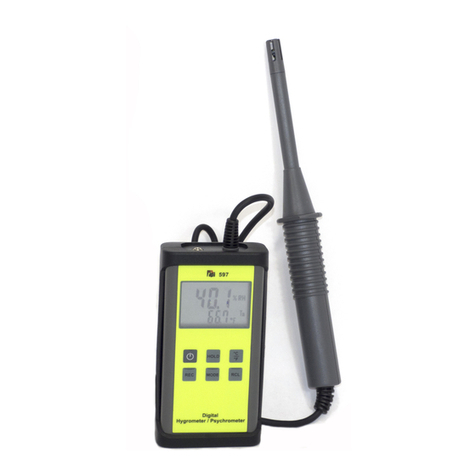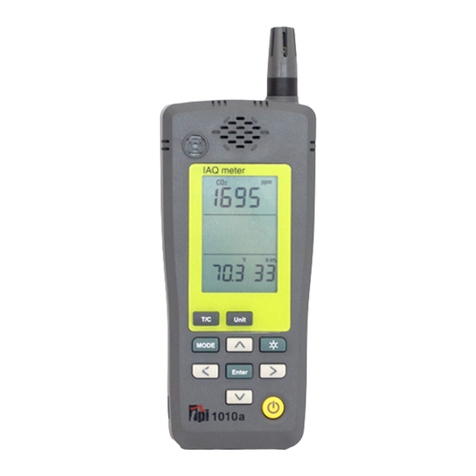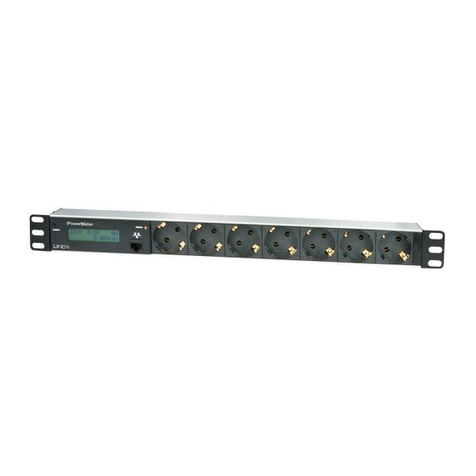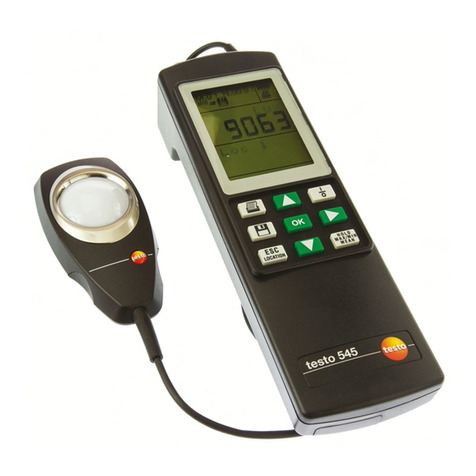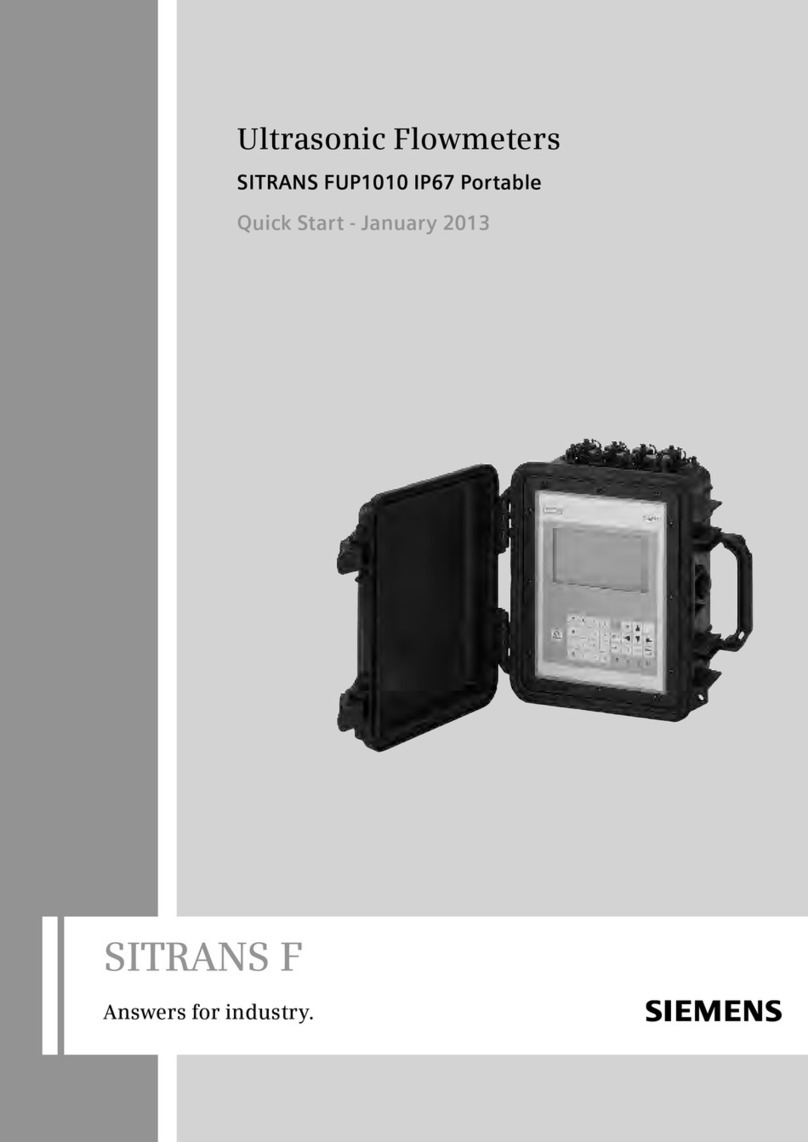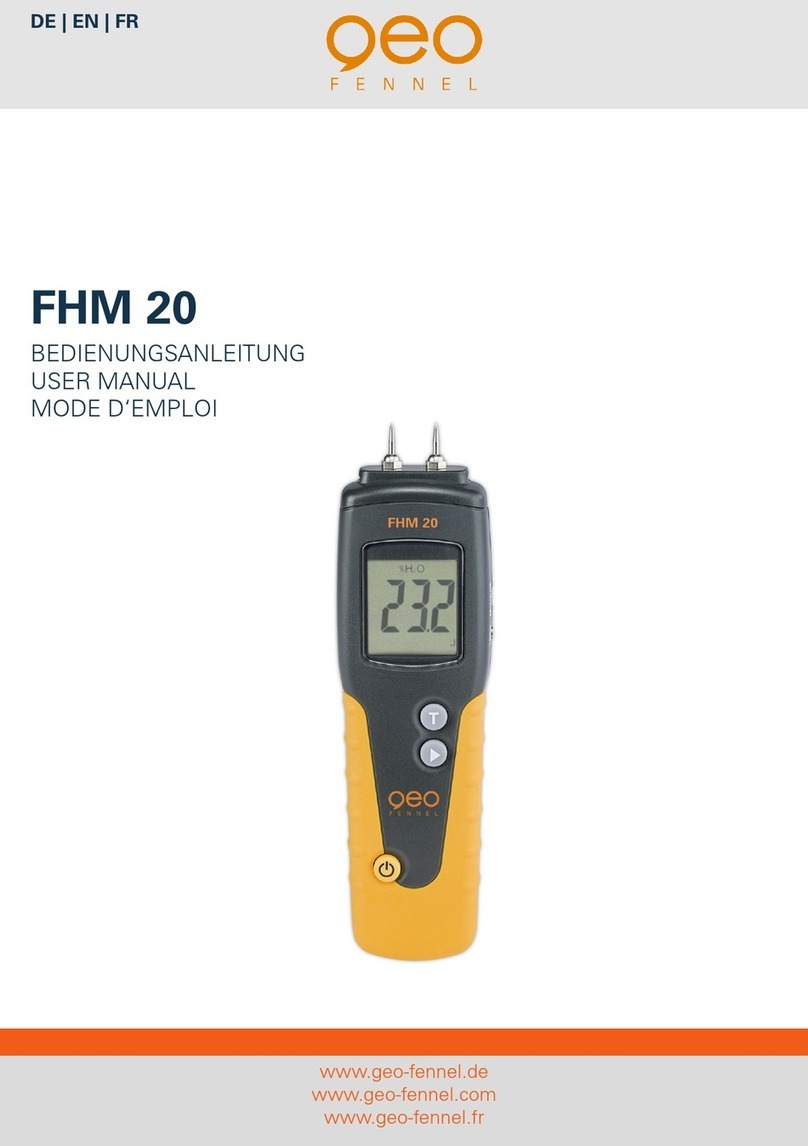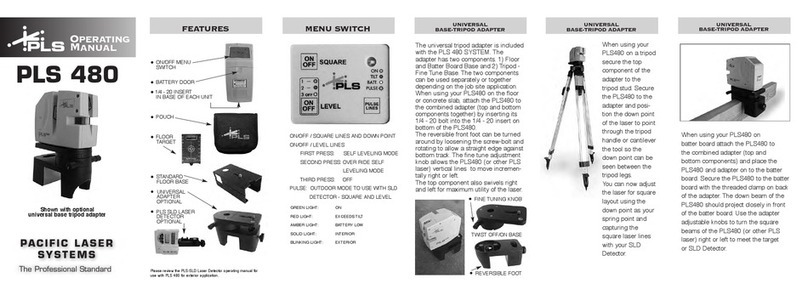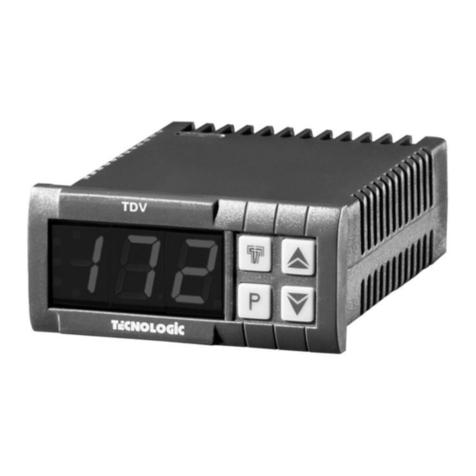TPI 717R User manual

TPI 717R
Combustion Flue Gas Analyser

Contents
1. Introduction
2. Instrument Overview
2.1 Front View
2.2 Back View
2.3 Side Views
2.4 Top View
3. Turning On
4. The 6 Functions
4.1 Function 1: - Flue Gas Analysis
4.2 Function 2: - Temperature Reading
4.3 Function 3: - Pressure Testing
4.4 Function 4: - Tightness/Let By Test
4.5 Function 5: - CO Build Up Test
4.6 Function 6: - Date/Time
5. Storing/Saving Data
6. Holding Data on Screen
7. Reviewing Data
8. Printing Data
9. Turning Off & Charging
Appendix A Specifications
Appendix B Calibration & Service
Appendix C Guarantee
Appendix D Troubleshooting Guide
Appendix E Index

1. Introduction
Thank you for purchasing TPI brand products. The TPI 717R Combustion
Analyser is a state of the art, easy to use analyser designed not only to display
and calculate the required readings from a flue but also to cover most of the other
desirable parameters associated with appliance installation and maintenance.
The instrument is ruggedly constructed and comes with a limited 6 Year
Warranty*.
This manual will guide you through the functions of the TPI 717R, which will give
you many years of reliable service. The TPI 717R software has in-built self-
diagnostics that can easily be interrogated by our fully qualified and professional
engineers should an error occur. Please call the number below before returning
your instrument to your distributor should an error occurs. We can rectify over
75% of proposed faults over the phone.
TPI HELPLINE
01293 530196 opt. 1
Your TPI 717R Combustion Analyser comes complete with the following items as
standard: -
TPI 717R Instrument c/w Integral Magnet
Rubber Boot
Soft Carrying Case
Sampling Probe (c/w Type “K” Thermocouple)
In-Line Water Trap Bowl Filter (c/w Spare Particle Filter)
Battery Charger
Mini In-Line Pump Protection Filter (c/w 5 spare filters)
Exhaust Spigot (removable)
Pressure Tubing (2 x 1 metres)
GK11M Air Probe
Instruction Manual
Your TPI 717R Combustion Analyser has the following options available: -
Infrared Printer (see Appendix B)
Various Temperature Probes (see Appendix B)
Oil Filter (see Appendix B)
Smoke Test Pump (see Appendix B)
*subject to annual servicing & re-certification being carried out by TPI Europe or one of
its approved service centres.

2. Instrument Overview
2.1 Front View
Rubber Boot Protects the instrument from accidental damage
Display Large 3 Parameter Backlit Display
Battery Indicator Showing battery life

Scrolls through selectable fuels (see 4.1.1, 4.1.3, 4.1.4 & 4.1.5)
Switches between ºC and ºF (see 4.1.6 & 4.2.1)
Scrolls through mbar, kPa and inH2O (see 4.3.1)
Selects “Pass”on the Let/By, Tightness Test (see 4.4)
Moves up through the Stored Data Addresses (see 5, 7 & 8)
Switches between Efficiency Options (see 4.1.1, 4.1.3, 4.1.4 & 4.1.5)
Zeroes pressure reading (see 4.3.1 & 4.4)
Selects “Pass” on the Let/By, Tightness Test (see 4.4)
Moves down through the Stored Data Addresses (see 5, 7 & 8)
Used to “HOLD” Data on Screen (see 6)
Scrolls through Flue Gas Analysis Function Screens (see 4.1 & 6)
Starts & Moves through the Let/By, Tightness Test (see 4.4)
Starts & Stops the CO Build-Up Test (see 4.5)
Allows you to choose a Stored Data Address (see 5, 7 & 8)
Sends stored data to a separate infrared printer (see 8)
Allows you to view stored data on the display (see 7)
Stores/Saves readings to memory (see 5)
Moves you through the 6 Functions (see 4)
Turns Backlight ON and OFF (see 4)
Used to Exit Review or Print Functions (see 7 & 8)
Turns the instrument ON and OFF (see 3 & 9)

2.2 Back View
Gas and Pressure Inlet Ports Connection for In-Line Pump Protection Filter
(see 2.4 & 3)
Connections for Pressure Tubing (see 2.4 & 4)
Calibration and Info Label Displays calibration information
Displays serial number
Battery Compartment Holds rechargeable battery
Rubber Boot Protects the instrument from accidental damage

2.3 Side Views
Exhaust Port Port for connection of Exhaust Adaptor
Infrared Window Window for sending stored data to IR Printer (see 8)
Rubber Boot Protects the instrument from accidental damage

2.4 Top View
Charger Socket Connection for 220V/115V charger (see 9.1)
Thermocouple Connection for thermocouple plug on probe (see 4.1)
T1 Socket Connection for any ‘K’ type thermocouple probe (see 4.2)
Thermocouple Connection for any ‘K’ type thermocouple probe (see 4.2)
T2 Socket
Gas Inlet Port Connection for In-Line Pump Protection Filter (see 3)
Pressure (+) Port Connections for Pressure Tubing (see 4.3 & 4.4)
Pressure (-) Port Connections for Pressure Tubing (see 4.3)

3. Turning On
3.1 Turning On
Always: - Before turning on please ensure
that the In-Line Pump Protection Filter
(shown across) is connected to the Gas
Sample Port (see 2.2 or 2.4).
**THIS MUST REMAIN ON THE UNIT
AT ALL TIMES.**
Failure to do so may result in pump failure
and will invalidate the warranty.
Press the Power Key for approximately 2 seconds and the TPI 717R will
start up and display ALL Segments on the display for approx. 1 second. The
717R will then enter its 30-second purge period, briefly displaying the Software
Version & Instrument Serial Number, before continuing with the countdown where
upon the following screen will be displayed.
The instrument should ALWAYS be turned
on in a clean air environment as the 30
second purge will attempt to set the
Carbon Monoxide level to 0 ppm and the
Oxygen to 20.9%.
If there is insufficient clean air in the sensor
chamber after the 30 second purge period an
error indicating this may be displayed, please
see troubleshooting guide (appendix D) for
appropriate remedy. If the error is still present
after attempting the suggested remedy please
call the
TPI HELPLINE
01293 530196 opt. 1
717R

4. THE 6 FUNCTIONS
After the 30-second countdown the instrument is ready to take Flue Gas,
Temperature or Pressure readings and will Display the following Screen.
You are now ready to take Flue Gas Analysis
Readings. Please continue on with the manual from
Section 4.1 (below) which will guide you through the
various Analysis Screens.
However, if you do not wish to perform a Flue Test at
this moment Press the Func/Backlight Key
and move onto Section 4.2 of the manual.
At any time you can activate the Backlight by holding down the
Func/Backlight Key for 2 seconds.
4.1 Function 1: - Flue Gas Analysis
Ensure you have connected the Temperature Sampling Probe complete with
In-Line Water Trap Bowl Filter to the In-Line Pump Protection Filter (See 3)
which should ALWAYS be connected to the Gas Sample Port (see 2.2 or 2.4)
and that the ‘K’ Type Thermocouple Plug is in Thermocouple Socket (ch1)
(see 2.4). Also ensure that a ‘K’ Type Air Probe is connected to
Thermocouple Socket (ch2) (see 2.4) in order to calculate efficiency.

Your temperature-sampling probe comes complete with an In-Line Water Trap
Bowl Filter as standard.
This consists of a Particle Filter in
the Bowl Compartment and a Disc
Filter in the Lid (as shown in the
diagram across). The Disc Filter in
Lid will prevent any excessive water
from entering the 717R Combustion
Analyser if used correctly.
If you are working with OILthen you MUST ensure that you also use the optional
Oil Filter as shown below. Failure to do so will result in erroneous readings.
If any of the filters become excessively dirty or blocked then the
following screen will be displayed as a warning and no further
readings will be able to be taken until either the dirty filters are
replaced or the blockage removed:-
The 717R will also give off an audible Beeping Alarm
to warn that a “FLo Err” is being detected

WARNING: - Ensure that the In-Line Water Trap Bowl Filter hangs in a vertical
position whilst readings are being taken, particularly if water is visible (see below).
Failure to comply may result in damage to the instrument and will invalidate
the warranty.
WARNING: - There is ONLY one correct way to connect the
‘K’ type thermocouple plug into the socket (see 2.4). The
thermocouple plug is designed with one thick (negative) and
one thinner (positive) prong. Forcing the plug into the socket
the wrong way round may result in damage to the instrument.
Failure to comply may result in damage to the instrument
and will invalidate the warranty.
Pressing the Enter Key will take you through the following Flue Gas
Analysis Screens
4.1.1 Screen 1
Displays Carbon Monoxide (CO) reading in parts per
million (ppm)
Displays calculated Carbon Dioxide (CO2) figure in
percentage (%)
Displays calculated CO/CO2(Ratio) figure
Pressing the Up Arrow Key will toggle between
the Fuel Options
Pressing the Down Arrow Key will toggle
between the Efficiency Options

4.1.2 HIGH CO ALARM
Should the CO reading rise above 2,000ppm a continuous series of Alarm Beeps
will be heard. This Alarm alerts the user that there is a high concentration of CO
and that there may be a potential problem with the appliance. The instrument will
continue to monitor CO up to 10,000ppm but the longer the probe is left attached
to the instrument sampling at these high levels the longer the recovery time back
to ambient air before the instrument will be able to be switched off (see 4.1.7 –
Failsafe Turn Off).
4.1.3 Screen 2
Displays Oxygen (O2) reading in percentage (%)
Displays calculated Excess Air (X Air) figure in
percentage (%)
Displays calculated Efficiency (Eff.) figure in percentage
(%)
Pressing the Up Arrow Key will toggle between
the Fuel Options
Pressing the Down Arrow Key will toggle
between the Efficiency Options
4.1.4 Screen 3
Displays Carbon Monoxide (CO) reading in parts per
million (ppm)
Displays Oxygen (O2) reading in percentage (%)
Pressing the Up Arrow Key will toggle between
the Fuel Options
Pressing the Down Arrow Key will toggle
between the Efficiency Options

4.1.5 Screen 4
Displays CO air free calculated reading
Pressing the Up Arrow Key will toggle between
the Fuel Options
Pressing the Down Arrow Key will toggle
between the Efficiency Options
4.1.6 Screen 5
Displays Temperature reading of T1 in degrees
Centigrade (ºC)
Displays Temperature reading of T2 in degrees
Centigrade (ºC)
Displays the Differential Temperature (Diff.) between T1
and T2 in ºC
‘oPEn’ will be displayed if no ‘K’ type probe is
connected to the thermocouple socket
Pressing the Up Arrow Key will toggle between
ºC and ºF
4.1.7 CO above 15ppm (Failsafe) Protection Beep
The 717R will not allow the user to either Turn the instrument OFF or to move to
another Function whilst the CO level is above 15ppm. A short beep will be heard
should the user attempt either of the above with the CO above 15ppm.
This is a Failsafe Feature of the 717R to protect the instrument from giving false
readings when next turned on. The 717R should be run in a clean air environment
with just the In-Line Pump Protection Filter attached until the CO level drops
below 15ppm. The 717R will then be able to be moved to a different function
screen or be turned OFF.

4.2 Function 2: - Temperature Reading
The pump will stop running when in this function
Remember:- It was the Function Key that got you here!!!
Ensure you have a ‘K’ type probe connected to one or both of the
thermocouple sockets T1 or T2 (see 4.2)
WARNING: - There is ONLY one correct way to connect the
‘K’ type thermocouple plug into the socket (see 2.4). The
thermocouple plug is designed with one thick (negative) and one
thinner (positive) prong. Forcing the plug into the socket the
wrong way round may result in damage to the instrument.
Failure to comply may result in damage to the instrument
and will invalidate the warranty.
4.2.1 Screen 1
Displays Temperature reading of T1 in degrees
Centigrade (ºC) or degrees Fahrenheit (ºF)
Displays Temperature reading of T2 in degrees
Centigrade (ºC) or degrees Fahrenheit (ºF)
Displays the Differential Temperature (Diff.) between
T1 and T2 in ºC or ºF
Pressing the Up Arrow Key will toggle between
ºC and ºF
‘oPEn’ will be displayed if no ‘K’ type probe is
connected to the thermocouple socket

4.3 Function 3: - Pressure Testing
The pump will stop running when in this function
Remember:- It was the Function Key that got you here!!!
Ensure you have Pressure Sampling Tube connected to one or both of the
Pressure Ports (see 2.2 or 2.4)
4.3.1 Screen 1
Displays Pressure reading in either millibars (mbar),
kiloPascals (kPa), or inches of Water (inH2O)
Pressing the Up Arrow Key will scroll through
mbar, kPa and inH2O
Pressing the Down Arrow Key will Zero the
Pressure reading

4.4 Function 4: - Tightness/Let By Test
Remember:- It was the Function Key that got you here!!!
This function is designed to step you through each stage of the Let-By/Timed
Tightness Test allowing you to Pass/Fail at the end of each stage and record the
results either to memory for future use or directly to the optional IR (A740) printer.
1. Connect up pressure tubing & zero, if necessary
by pressing the Down Arrow Key
2. Apply required amount of pressure
3. Press Enter Key to start the Test
4. The Initial Pressure will be stored at P1 and P2
will become the “Live” pressure.
5. The 717R will countdown from 60 seconds
6. Once the countdown is finished the 717R will
display P1, P2 and Differential (P2-P1) and give
you the option to “Pass” or “Fail” depending on
whether the readings are within the allowable
tolerance or not.
7. Choosing “Fail” by pressing the Down
Arrow Key will stop the test and allow you to, if
required, store/save (see section 5) or print (see
section 7) the readings so far.
8. Choosing “Pass” by pressing the Up
Arrow Key will take you to the next part of the
test –Stabilisation

9. Start the stabilisation part of the test by pressing
the Enter Key
10. The Initial Pressure will be stored at P1 and P2
will become the “Live” pressure.
11. The 717R will countdown from 60 seconds
12. Once the countdown is finished the 717R will
display P1, P2 and Differential (P2-P1) and give
you the option to “Pass” or “Fail” depending on
whether the readings are within the allowable
tolerance or not.
13. Choosing “Fail” by pressing the Down
Arrow Key will stop the test and allow you to, if
required, store/save (see section 5) or print
(see section 7) the readings so far.
14. Choosing “Pass” by pressing the Up
Arrow Key will take you to the next part of the
test –Tightness
15. Apply the required amount of pressure
16. Start the Tightness part of the test by pressing
the Enter Key
17. The Initial Pressure will be stored at P1 and P2
will become the “Live” pressure.
18. The 717R will countdown from 120 seconds

19. Once the countdown is finished the 717R will
display P1, P2 and Differential (P2-P1) and give
you the option to “Pass” or “Fail” depending on
whether the readings are within the allowable
tolerance or not.
20. Choosing “Fail” by pressing the Down
Arrow Key will stop the test and allow you to, if
required, store the readings so far.
21. Choosing “Pass” by pressing the Up
Arrow Key will take you to the Finish screen
22. From the Finish Screen you can store/save (see
section 5) or print (see section 7) the
readings/test
4.5 Function 5: - CO Build Up Test
Remember:- It was the Function Key that got you here!!!
The CO room test function enables the 716 to monitor and log ambient CO levels
in a room or office space at 1 minute interval up to a total of 50 minutes. This data
can be retrieved later via the optional infrared printer.
1. Begin with the 717R in a fresh clean air
environment
2. Press the Enter Key start to the CO Room
Test
3. The 717R will start and record the CO level every
60 seconds and count up to 50 on the screen
4. At any time you can stop the test by pressing the
Enter Key
5. At the end of the test you can store/save (see
section 5) or print (see section 7) the readings

4.6 Function 6: - Date/Time
1. Press the Print Key & Down Arrow Key for 3 seconds to allow
you to change the Time, Date and Year
2. Use the Print & Recall Keys to choose the “Flashing
Numeric” to change
3. Use the Up & Down Arrow Keys to make the changes
4. Once the changes have been made press the Store/Save Key
5. Press the Enter Key to exit and return back to the Date/Time
Screen
Table of contents
Other TPI Measuring Instrument manuals
Popular Measuring Instrument manuals by other brands
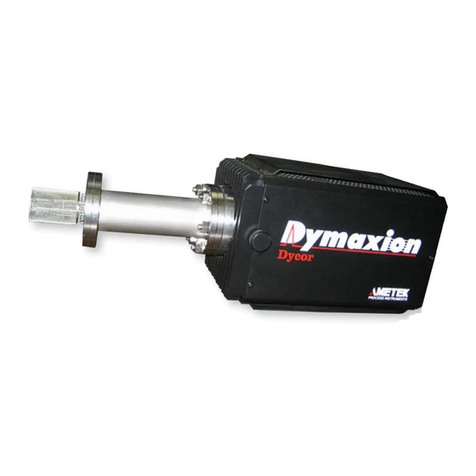
Ametek
Ametek Dycor DM100 user manual

Wetekom
Wetekom 79 71 59 instruction manual

Optima Home Scales
Optima Home Scales VITALIZE user manual
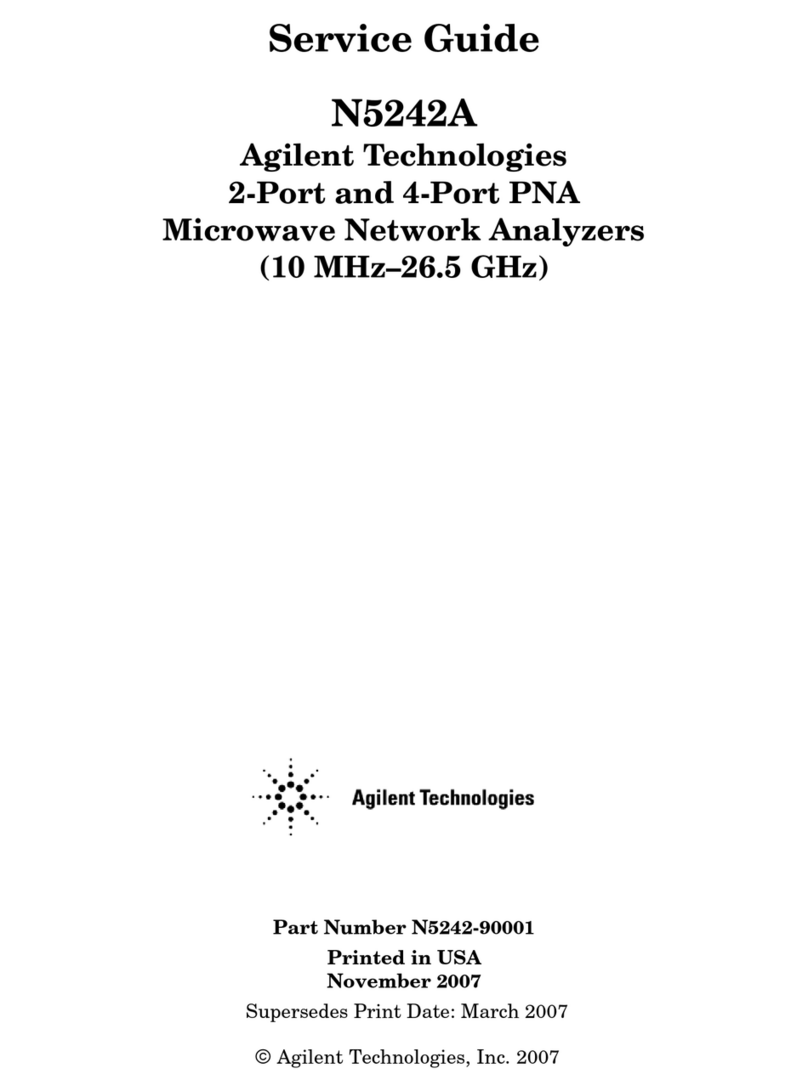
Agilent Technologies
Agilent Technologies N5242A Service guide
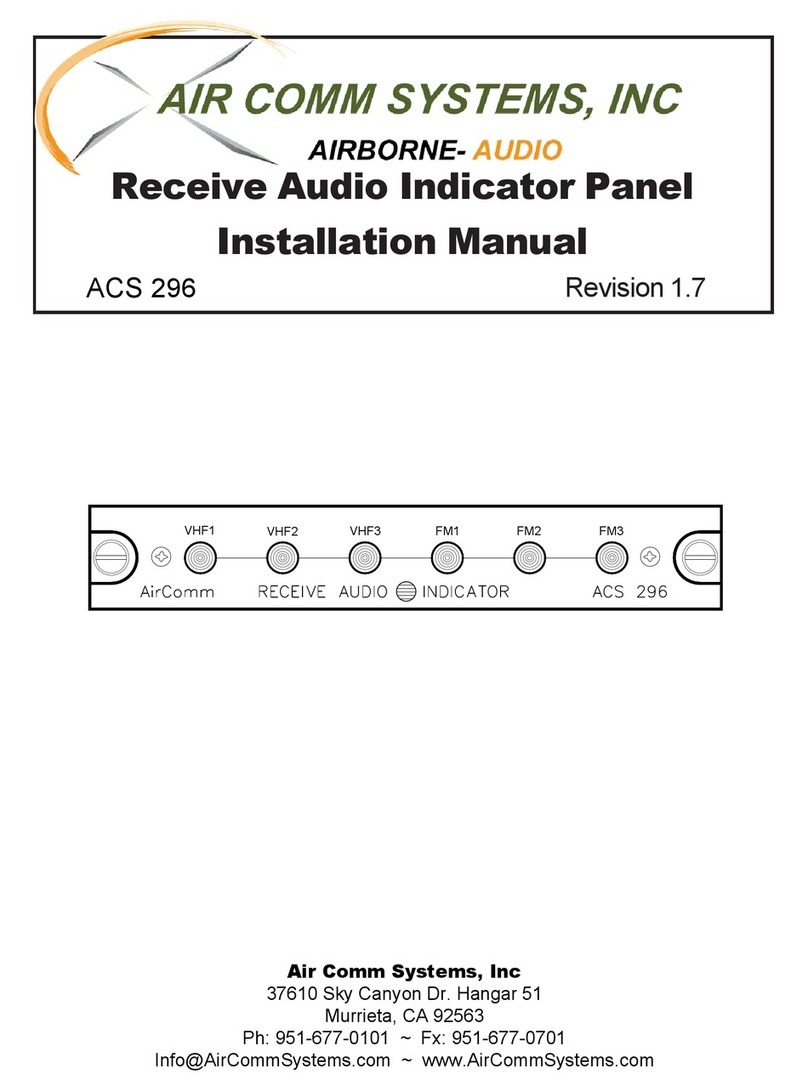
Air Comm Systems
Air Comm Systems ACS 296 installation manual
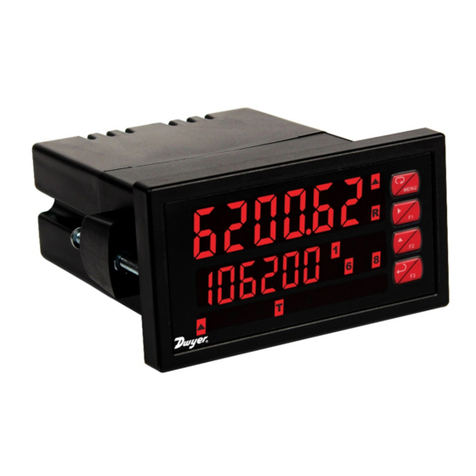
Dwyer Instruments
Dwyer Instruments Series APM instruction manual
